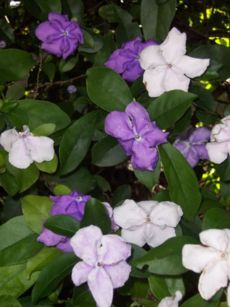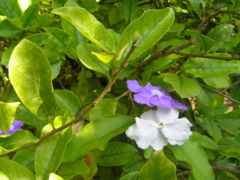Brunfelsia: Difference between revisions
No edit summary |
No edit summary |
||
| Line 1: | Line 1: | ||
{{SPlantbox | |||
|genus=Brunfelsia | |||
|Temp Metric=°F | |||
|jumpin=If this plant info box on watering; zones; height; etc. is mostly empty you can click on the edit tab and fill in the blanks! | |||
|image=Upload.png | |||
|image_width=240 | |||
}} | |||
{{Inc| | |||
Brunfelsia (Otto Brunfels, physician and botanist of the sixteenth century). Francisceae. Solanaceae. Trees and shrubs, a few of which are grown in warm glasshouses. | |||
Leaves entire, oblong, often shining: fls. in terminal cymes or clusters, or solitary, large and showy, sometimes fragrant; corolla with 5 rounded and nearly equal spreading lobes (or 2 of them a little more united); stamens 4, in the throat of the corolla, the anthers all alike: fr. berry-like.—Species above 20, in Cent, and S. Amer. and W. Indies. | |||
Brunfelsias are usually winter-flowering plants. The wood must be well ripened before flowering begins. Grow in a rich open compost, and feed liberally when well rooted. They need a night temperature of 50 . They bloom best when pot-bound. Propagated by cuttings from the new growth in spring, or from pieces of the ripe wood in autumn inserted in very sandy soil and peat and kept close and shaded until rooted. The plants are of easy culture when the simple requirements are understood. Under glass, the bloom begins usually in October and November. They are showy open-air plants in Florida and southern California. | |||
}} | |||
{{Taxobox | {{Taxobox | ||
| color = lightgreen | | color = lightgreen | ||
Revision as of 23:06, 13 February 2010
| Brunfelsia subsp. var. | ||||||||||||||||||||||||||||||||||||||||||||||||||||||||
|---|---|---|---|---|---|---|---|---|---|---|---|---|---|---|---|---|---|---|---|---|---|---|---|---|---|---|---|---|---|---|---|---|---|---|---|---|---|---|---|---|---|---|---|---|---|---|---|---|---|---|---|---|---|---|---|---|

|
|
| ||||||||||||||||||||||||||||||||||||||||||||||||||||||
| ||||||||||||||||||||||||||||||||||||||||||||||||||||||||
| Standard Cyclopedia of Horticulture |
|---|
|
Brunfelsia (Otto Brunfels, physician and botanist of the sixteenth century). Francisceae. Solanaceae. Trees and shrubs, a few of which are grown in warm glasshouses. Leaves entire, oblong, often shining: fls. in terminal cymes or clusters, or solitary, large and showy, sometimes fragrant; corolla with 5 rounded and nearly equal spreading lobes (or 2 of them a little more united); stamens 4, in the throat of the corolla, the anthers all alike: fr. berry-like.—Species above 20, in Cent, and S. Amer. and W. Indies. Brunfelsias are usually winter-flowering plants. The wood must be well ripened before flowering begins. Grow in a rich open compost, and feed liberally when well rooted. They need a night temperature of 50 . They bloom best when pot-bound. Propagated by cuttings from the new growth in spring, or from pieces of the ripe wood in autumn inserted in very sandy soil and peat and kept close and shaded until rooted. The plants are of easy culture when the simple requirements are understood. Under glass, the bloom begins usually in October and November. They are showy open-air plants in Florida and southern California.
|
| Brunfelsia {{{status}}} Fossil range: {{{fossil_range}}}
| ||||||||||||||||||||||||||||||||||||||||||||||||||||||||||||||||||
|---|---|---|---|---|---|---|---|---|---|---|---|---|---|---|---|---|---|---|---|---|---|---|---|---|---|---|---|---|---|---|---|---|---|---|---|---|---|---|---|---|---|---|---|---|---|---|---|---|---|---|---|---|---|---|---|---|---|---|---|---|---|---|---|---|---|---|
 | ||||||||||||||||||||||||||||||||||||||||||||||||||||||||||||||||||
| Plant Info | ||||||||||||||||||||||||||||||||||||||||||||||||||||||||||||||||||
| ||||||||||||||||||||||||||||||||||||||||||||||||||||||||||||||||||
| Scientific classification | ||||||||||||||||||||||||||||||||||||||||||||||||||||||||||||||||||
| ||||||||||||||||||||||||||||||||||||||||||||||||||||||||||||||||||
| [[{{{diversity_link}}}|Diversity]] | ||||||||||||||||||||||||||||||||||||||||||||||||||||||||||||||||||
| {{{diversity}}} | ||||||||||||||||||||||||||||||||||||||||||||||||||||||||||||||||||
| Binomial name | ||||||||||||||||||||||||||||||||||||||||||||||||||||||||||||||||||
| {{{binomial}}} | ||||||||||||||||||||||||||||||||||||||||||||||||||||||||||||||||||
| Trinomial name | ||||||||||||||||||||||||||||||||||||||||||||||||||||||||||||||||||
| {{{trinomial}}} | ||||||||||||||||||||||||||||||||||||||||||||||||||||||||||||||||||
| Type Species | ||||||||||||||||||||||||||||||||||||||||||||||||||||||||||||||||||
| {{{type_species}}} | ||||||||||||||||||||||||||||||||||||||||||||||||||||||||||||||||||
| Species | ||||||||||||||||||||||||||||||||||||||||||||||||||||||||||||||||||
| See text | ||||||||||||||||||||||||||||||||||||||||||||||||||||||||||||||||||
| [[Image:{{{range_map}}}|{{{range_map_width}}}|]] | ||||||||||||||||||||||||||||||||||||||||||||||||||||||||||||||||||
| Synonyms | ||||||||||||||||||||||||||||||||||||||||||||||||||||||||||||||||||
| {{{synonyms}}} |
Brunfelsia is a genus of about 40 species of neotropical shrubs and small trees.
The leaves are alternate and simple, with shapes generally elliptic to ovate. The flowers are large and tubular, with five broad petals. Typical habitat is light woodland and thickets.
Species in cultivation include Brunfelsia americana ("lady of the night") and Brunfelsia pauciflora.
Linnaeus named the genus for early German herbalist Otto Brunfels (1488-1534).
Many members of this genus contain toxic and medicinal alkaloids. Brunfelsia grandiflora is used by curanderos in South America as an additive to ayahuasca and contains the psychoactive alkaloid scopoletin. Brunfelsia hopeana contains the alkaloid hopeanine.
